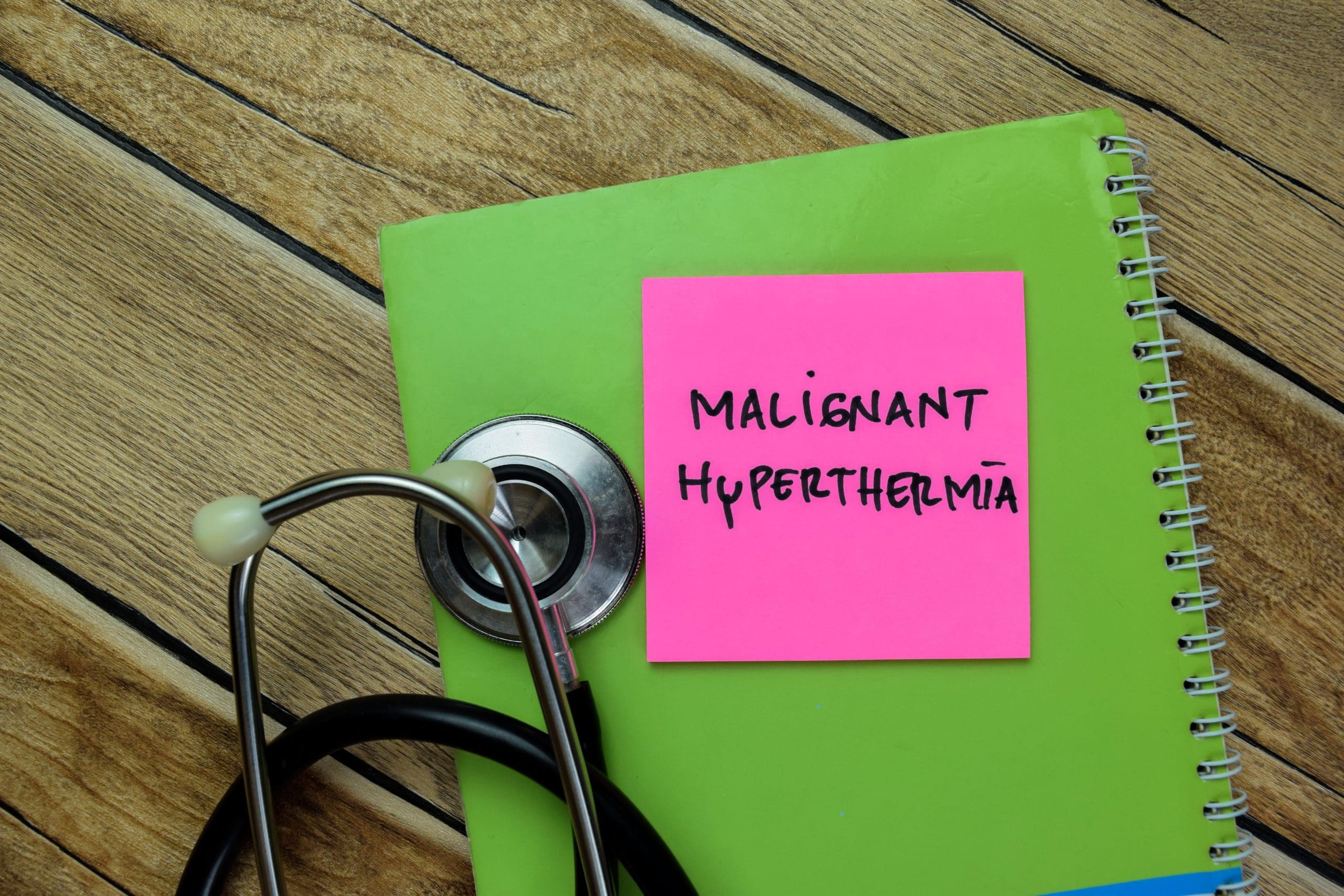Nurse knowledge prompts quick intervention.
- Malignant hyperthermia occurs in about 1 in 30,000 surgeries in patients younger than 19 years of age.
- Recognition and intervention require knowledge of risk factors, patient family history, and known triggering agents, including strong anesthetics and neuromuscular blocking agents.
- Thorough assessments, prompt interventions, and maintenance of a malignant hyperthermia care aid appropriate intervention.
Daniel Sanchez*, an 8-year-old boy, arrives in the pediatric recovery unit after an appendectomy. You note that his electronic health record (EHR) indicates Daniel weighs 57 lbs (25.8 kg) and that he’s in good overall health with no significant medical history. After he’s extubated, his parents enter the room. Because Daniel is moaning, clenching his jaw, and grimacing, the parents ask if he’s experiencing pain and if he can be prescribed medication to relieve it.
Daniel’s vital signs are temperature 99.0° F (37.2° C), HR 100 bpm, RR 24, and BP 105/60 mmHg. Your assessments are normal. The provider orders include I.V. morphine sulfate 0.1 mg/kg every 4 hours as needed for severe pain. After calculating the dose, you administer the morphine at 0.1-0.2 mg/kg via slow I.V. push.
Re-assessment
You return 5 minutes later to re-assess Daniel and note that he’s no longer moaning. However, his temperature is now 102.5° F (39.2° C); he has tachycardia (HR 130 bpm) and tachypnea (RR 30); and his BP is 120/80 mmHg. The surgical dressing is clean, dry, and intact, and the patient’s skin is warm and moist, but you’re concerned about the sudden onset of hyperthermia and tachypnea. You note that Daniel clenches his teeth when answering about his pain and you see some temporal facial muscle tetany. You ask the parents if there’s a family history of issues related to anesthesia. The father explains that he nearly died after surgery in response to anesthesia.
You note that Daniel received succinylcholine and propofol intraoperatively. Recognizing the signs of malignant hyperthermia (muscle rigidity/tetany, marked temperature elevation, tachycardia, tachypnea, increased CO2 production, respiratory/metabolic acidosis, rhabdomyolysis, dark urine, and hyperkalemia/cardiac arrhythmias), you activate the rapid response team.
On the scene
You provide the rapid response team with Daniel’s family history, your assessment findings, and his vital signs. The team infuses cool I.V. fluids and applies ice packs to Daniel’s body. The anesthesiologist immediately orders dantrolene 65 mg (2.5 mg/kg) as an initial loading dose, repeating it every 3 to 5 minutes until all signs have disappeared. Daniel is transferred to the pediatric ICU.
Education
Although rare, malignant hyperthermia causes a hypermetabolic crisis that, if unrecognized or untreated, can result in death. Malignant hyperthermia occurs in about 1 in 30,000 surgeries in patients younger than 19 years of age. Quick recognition and intervention require nurse knowledge of risk factors, such as a family history (it’s an autosomal dominant inherited trait), and known triggering agents—such as strong anesthetics (halothane, sevoflurane, or desflurane) and neuromuscular blocking agents (succinylcholine). Later signs of malignant hyperthermia may include bleeding and seizures. Performing thorough assessments with prompt interventions, maintaining a malignant hyperthermia cart, and practicing via simulation can help save lives. (To view a list of malignant hyperthermia cart supplies, visit bit.ly/45o9JoX.)
Malignant hyperthermia cart
A malignant hyperthermia cart should contain the following supplies:
- Arterial blood gas kits (six) or per facility OR iSTAT supplies with tuberculin syringes
- Blood culture bottles (one set)
- Blunt needles (ten)
- Bucket for ice
- Calcium chloride (10%) two 10-mL vials
- Charcoal filters (two)
- Dantrium: 36 vials (dilute with 60 mL sterile water) OR dantrolene: 3 vials (dilute with 5 mL of sterile water for injection)
- Dextrose 50% 50 mL vials
- Disposable cold packs (four)
- Esophageal, bladder, or other temperature probe
- I.V. catheters (4 each of 24 g, 22 g, 20 g, 19 g, 18 g)
- Lidocaine for injection (2%) 100 mg/5 mL or 100 mg/10 mL in preloaded syringes (amiodarone also acceptable)
- Normal saline: 1,000 mL cooled for I.V. infusion
- Pediatric central venous pressure kit
- Pediatric transducer kit/supplies
- Pressure bag
- Regular insulin 100 units/mL (refrigerated)
- Serum lab tubes (complete blood count, platelets, creatine kinase, myoglobin, SMA 19 or LDH, electrolytes, thyroid studies, PT/PTT, fibrinogen, fibrin split products, and lactate)
- Sodium bicarbonate (8.4%) four 50-mL vials
- Sterile drape (one)
- Sterile water vials: 100 mL
- Syringes: 60 mL, 5 mL, and 3 mL (five)
- Urine collection container (one)
- Urine hemoglobin test strips
- Urine meter
- Zip lock bags for ice (four large and four small)
Outcome
Daniel’s condition stabilizes in the pediatric ICU after dantrolene administration and ventilator support. Your quick recognition of the early symptoms of malignant hyperthermia and prompt intervention ensure a good outcome.
*Name is fictitious.
Lisa Wallace is an assistant professor at Morehead State University in Morehead, Kentucky.
American Nurse Journal. 2023; 18(9). Doi: 10.51256/ANJ092387
References
Cleveland Clinic. Malignant hyperthermia. April 25, 2022. my.clevelandclinic.org/health/diseases/17945-malignant-hyperthermia
Lapisatepun W, Arkarattanakul S. Early recognition and treatment of malignant hyperthermia in pediatric patient during bronchoscopy. Case Rep Anesthesiol. 2020:6562896. doi:10.1155/2020/6562896
Mathur PR, Rundla M, Jain N, Mathur V. Malignant hyperthermia in a 6-month-old infant. Saudi J Anaesth. 2016;10(3):353-5. doi:10.4103/1658-354X.174915
Rosenbaum HK, Rosenberg H. Malignant hyperthermia: Diagnosis and management of acute crisis. UptoDate. March 25, 2022. uptodate.com/contents/malignant-hyperthermia-diagnosis-and-management-of-acute-crisis
Rosenberg H, Pollock N, Schiemann A, Bulger T, Stowell K. Malignant hyperthermia: A review. Orphanet J Rare Dis. 2015;10:93. doi:10.1186/s13023-015-0310-1
Taylor LA. In search of an ethical constraint on hospital revenue. The Hastings Center. April 14, 2023. thehastingscenter.org/in-search-of-an-ethical-constraint-on-hospital-revenue
Wei H, Sewell KA, Woody G, Rose MA. The state of the science of nurse work environments in the United States: A systematic review. Int J Nurs Sci. 2018;5(3):287-300. doi:10.1016/j.ijnss.2018.04.010
Weiner-Lastinger LM, Pattabiraman V, Konnor RY, et al. The impact of coronavirus disease 2019 (COVID-19) on healthcare-associated infections in 2020: A summary of data reported to the National Healthcare Safety Network. Infect Control Hosp Epidemiol. 2022;43(1):12-25. doi:10.1017/ice.2021.362
Key words: pediatric malignant hyperthermia, anesthesia, hypermetabolic crisis


















